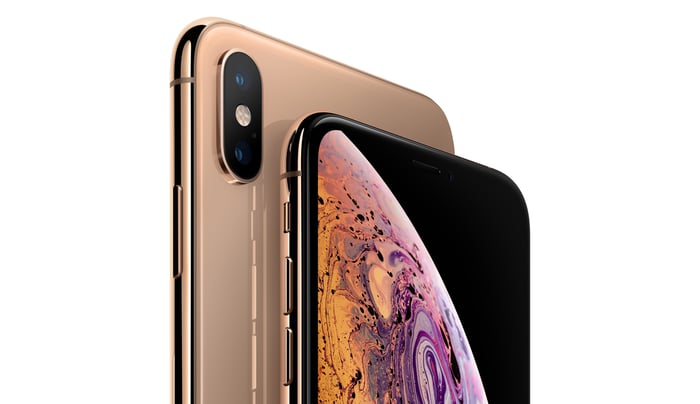The biggest surprise yesterday from Apple's (AAPL -2.19%) big iPhone event was how the company decided to price the 2018 lineup. Many analysts had expected the company to decrease iPhone pricing, including highly respected analyst Ming-Chi Kuo, who thought Apple would price the iPhone XR at $600 to $700, the iPhone XS at $800 to $900, and the iPhone XS Max at $900 to $1,000 in order to drive unit growth. Manufacturing costs have certainly come down, but the big question was whether Apple would pass those savings along to consumers or pocket them to boost margins.
It chose the latter.

Image source: Apple.
Moving on up
Apple kept the iPhone XS at the same $999 price point while positioning the iPhone XS Max even higher at a whopping $1,099. Last year's iPhone X only had one additional storage tier: 256GB for $1,149. That price point -- which was the previous ceiling on the 2017 iPhone lineup -- is also unchanged, but there are now some even more expensive configurations throughout the lineup, reaching all the way up to $1,449 for a fully loaded iPhone XS Max with 512GB of storage (more than an entry-level MacBook Pro).
|
Storage Configuration |
iPhone XS |
iPhone XS Max |
|---|---|---|
|
64GB |
$999 |
$1,099 |
|
256GB |
$1,149 |
$1,249 |
|
512GB |
$1,349 |
$1,449 |
Data source: Apple.
CEO Tim Cook has noted that iPhone X has been the top-selling model over the past year, and this was the first cycle in which the most popular model was also the most expensive model. That might not hold true again this year, as giant phones aren't for everyone. Still, Apple is reaching even higher in iPhone pricing, which suggests there should be plenty of average selling price (ASP) upside. Note that iPhone X drove ASPs to record levels ($796) in the fourth quarter. There is another aspect to consider, though.
iPhone XR might cannibalize iPhone XS
Apple has never worried about cannibalization risk, famously saying it would prefer to cannibalize itself rather than let a competitor do so. Still, investors should be aware of the dynamics of the business. iPhone XR looks like a very compelling product, priced at a much more affordable $750 and offered in a greater range of colors for more personalization. While its specs aren't as strong as those of the XS on paper, the iPhone XR does get many of the same headline features as the flagship, including Face ID, an edge-to-edge display with no home button, and the same A12 Bionic chip inside.
For many average consumers that don't care about or can't discern the differences -- like LCD vs. OLED, lower pixel density, single-camera instead of dual-camera, among others -- the XR could be a viable alternative at $250 less. To the extent that iPhone XR demand exceeds expectations, that could mitigate the potential for gains in ASP.
Pricing power has driven all revenue growth
In no uncertain terms, all iPhone revenue growth over the past year has been attributable to pricing power instead of unit growth.

Data source: SEC filings.
With unit volumes seeming to have plateaued, price increases have proven to be an especially potent strategy for growing the iPhone business. Maybe we should be less surprised that Apple kept iPhone pricing as high as it did.





